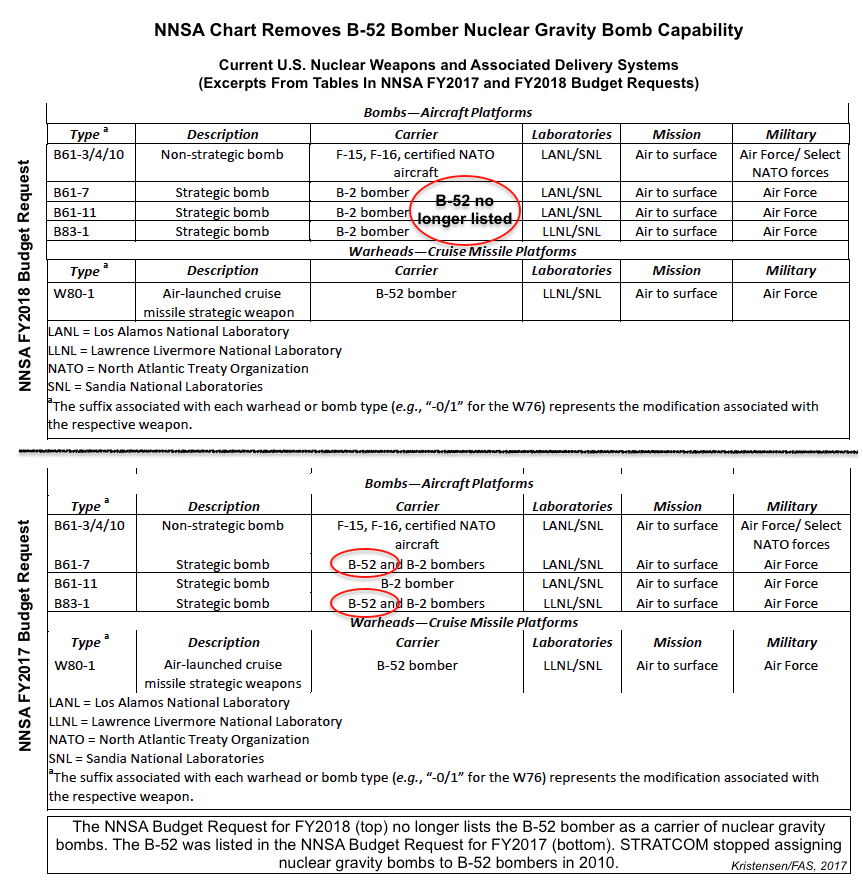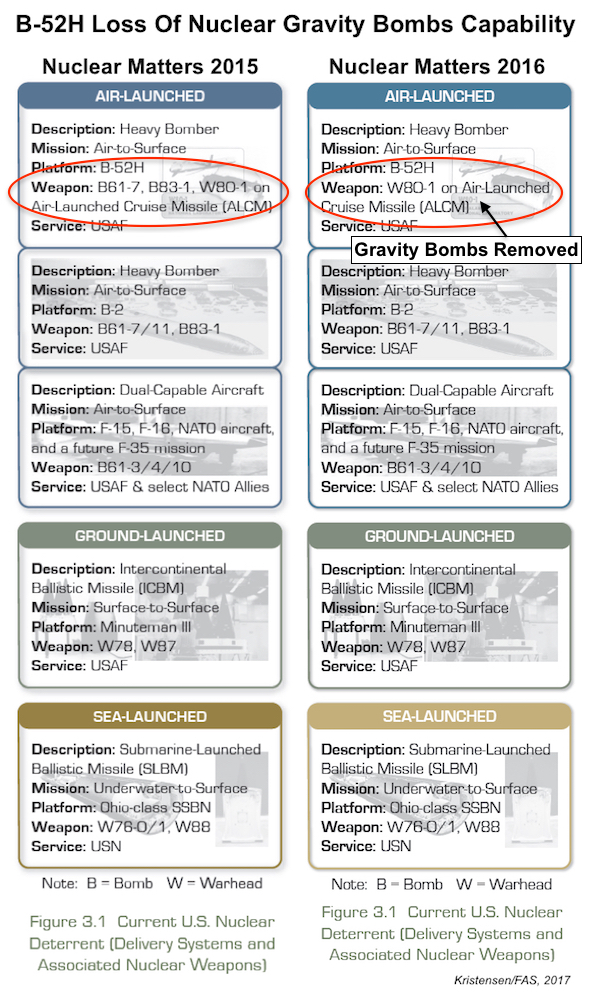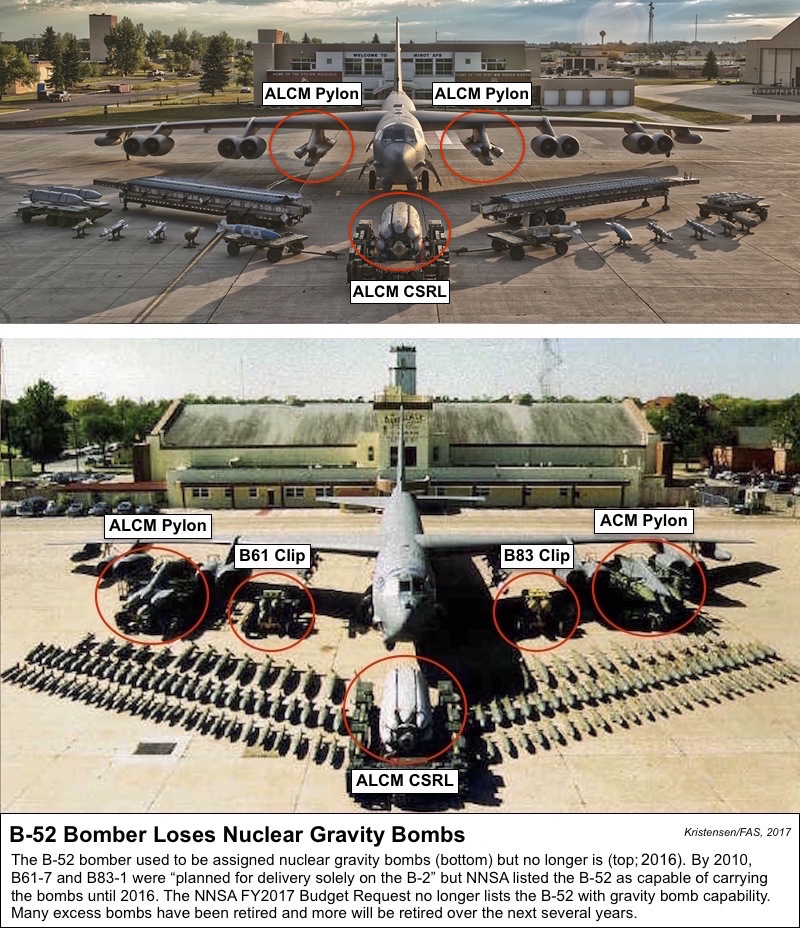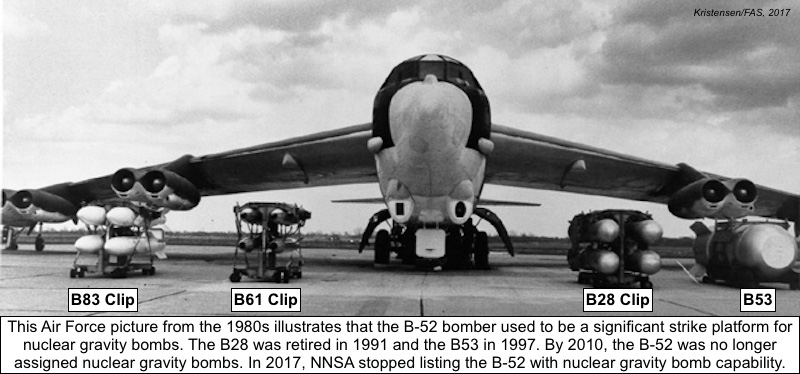USAF Upgrades Secrecy of Nuclear Weapons Inspections
The U.S. Air Force has upgraded the classification of information pertaining to nuclear weapons inspections performed by the Inspector General, reducing or eliminating public references to the outcome of such inspections.
Until recently, the IG weapons inspections could be described in unclassified reports. Now they will be classified at least at the Confidential level.
An Air Force nuclear surety inspection (NSI) “assesses a unit’s ability to accomplish its assigned nuclear weapons mission and produce reliable nuclear weapons in a safe and secure environment in compliance with applicable directives. Additionally, an NSI inspects a unit’s capability to safely and reliably receive, store, secure, assemble, transport, maintain, load, mate, lock/unlock, test, render safe and employ nuclear weapons.”
The inspections typically result in a “grade” indicating the level of compliance. Whether pass or fail, those grades, too, will now be classified.
The changes were made following the latest revision of Chairman of the Joint Chiefs Instruction (CJCSI) 3263.05C, Nuclear Weapons Technical Inspections, issued on March 10, 2017. Though unclassified, the Instruction is “Limited” in distribution and is not publicly available.
Even those nuclear weapons inspections that produce a finding of full compliance cannot be disclosed, and from now on they also cannot be acknowledged in military decorations or unit awards.
“These changes are control measures put in place to prevent revealing potential vulnerabilities to adversary forces,” wrote Staff Sgt. Alexx Pons of Air Force Public Affairs. See “Nuclear inspection grade restricted in evaluation, decoration and award comments,” June 14, 2017.
The results of nuclear weapons inspections have been published for decades, noted Hans Kristensen of the Federation of American Scientists, without any reported adverse effect on national security. So an alternate explanation for the new classification policy seems wanted. “The change sure looks handy for preventing the public from knowing embarrassing information about when Air Force units fail nuclear inspections,” he said.
Monitoring Nuclear Testing is Getting Easier
The ability to detect a clandestine nuclear explosion in order to verify a ban on nuclear testing and to detect violations has improved dramatically in the past two decades.
There have been “technological and scientific revolutions in the fields of seismology, acoustics, and radionuclide sciences as they relate to nuclear explosion monitoring,” according to a new report published by Los Alamos National Laboratory that describes those developments.
“This document… reviews the accessible literature for four research areas: source physics (understanding signal generation), signal propagation (accounting for changes through physical media), sensors (recording the signals), and signal analysis (processing the signal).”
A “signal” here is a detectable, intelligible change in the seismic, acoustic, radiological or other environment that is attributable to a nuclear explosion.
The new Los Alamos report “is intended to help sustain the international conversation regarding the [Comprehensive Test Ban Treaty] and nuclear explosive testing moratoria while simultaneously acknowledging and celebrating research to date.”
“The primary audience for this document is the next generation of research scientists that will further improve nuclear explosion monitoring, and others interested in understanding the technical literature related to the nuclear explosion monitoring mission.”
See Trends in Nuclear Explosion Monitoring Research & Development — A Physics Perspective, Los Alamos National Laboratory, LA-UR-17-21274, June 2017.
“A ban on all nuclear tests is the oldest item on the nuclear arms control agenda,” the Congressional Research Service noted last year. “Three treaties that entered into force between 1963 and 1990 limit, but do not ban, such tests. In 1996, the United Nations General Assembly adopted the Comprehensive Nuclear-Test-Ban Treaty (CTBT), which would ban all nuclear explosions. In 1997, President Clinton sent the CTBT to the Senate, which rejected it in October 1999.”
The Pentagon’s 2017 Report On Chinese Military Affairs
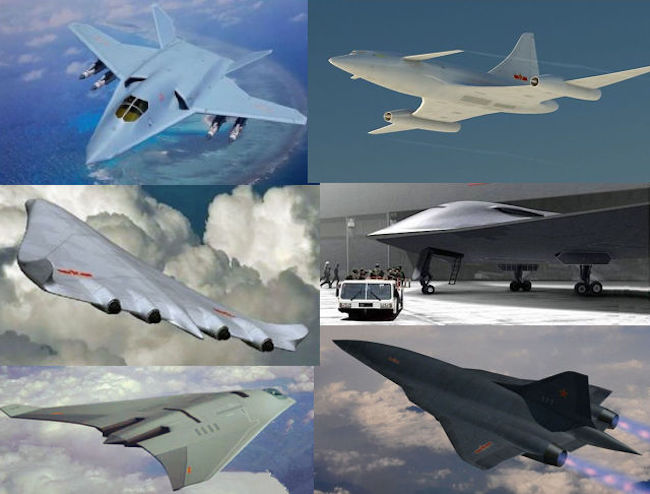
The Pentagon report says China is “developing a strategic bomber that officials expect to have a nuclear mission.” The Internet is full of artistic fantasies of what it might look like.
By Hans M. Kristensen
The Pentagon’s latest annual report to Congress on Chinese military and security developments describes a nuclear force that is similar to previous years but with a couple of important new developments in the pipeline.
The most sensational nuclear news in the report is the conclusion that China is developing a new strategic nuclear bomber to replace the aging (but upgraded) H-6.
The report also portrays the Chinese ICBM force as a little bigger than it really is because the report lists missiles rather than launchers. But once adjusted for that, the report shows the same overall nuclear missile force as in 2016, with two new land-based missiles under development (DF-26 and DF-41) but not yet operational.
The SSBN force is described as the same four boats but with “others” under construction. The report is a bit hasty to declare China now has a survivable sea-based deterrent, a condition that will require a few more steps.
Finally, the report concludes that Chinese nuclear strategy and doctrine, despite a domestic debate about scope and role, are unchanged from previous years.
Nuclear Bombers?
The Pentagon report states unequivocally that the Chinese Air Force “does not currently have a nuclear mission.” Yet bombers delivered nuclear gravity bombs in at least 12 of China’s nuclear test explosions between 1965 and 1979, so China probably has some dormant air-delivered nuclear capability.
But the report goes further by stating that China now “is developing a strategic bomber that officials expect to have a nuclear mission.”
In making this affirmative conclusion, the report refers to several sources. First, a 2016 statement by PLAAF commander Ma Xiaotian that China was “developing a next generation, long-range strike bomber” to replace the H-6 bombers. Second, the “nuclear” role is attributed to unidentified “observers” and speculations that “past PLA writings” about the need for a “stealth strategic bomber” suggests “aspirations to field a strategic bomber with a nuclear delivery capability.“
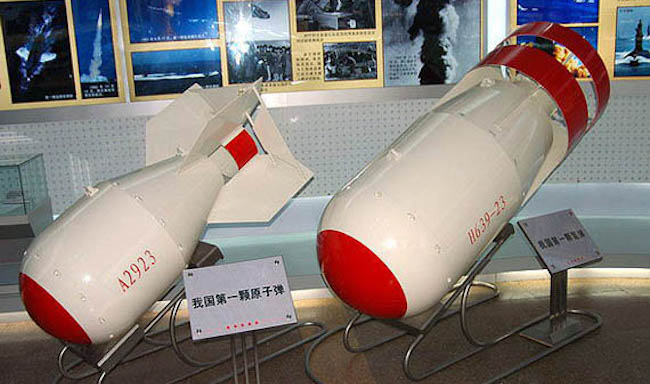
Although the Pentagon report says the Chinese Air Force does not currently have a nuclear mission, China has developed and tested nuclear gravity bombs. Mock-ups of the first fission bomb (left) and first thermonuclear bomb are on display in Beijing.
A U.S. Air Force Global Strike Command briefing in 2013 attributed nuclear capability to the CJ-20 air-launched cruise missile that is now operational with the H-6K bomber. And in May 2017, the U.S. Defense Intelligence Agency told Congress that China is “upgrading its aircraft…with two, new air-launched [ballistic cruise] missiles, one of which may include a nuclear payload.”
Whether a nuclear strategic bomber emerges sometime in the mid-2020s remains to be seen. If so, it would change China’s nuclear posture into a formal Triad of air-, land- and sea-based nuclear capabilities, similar to U.S. and Russian strategic arsenals.
The ICBM Force
The most mysterious nuclear number in the Pentagon report is this: “75-100 ICBMs.”
According to the report, “China’s nuclear arsenal currently consists of approximately 75-100 ICBMs, including the silo-based CSS-4 Mod 2 (DF-5A) and Mod 3(DF-5B); the solid-fueled, road-mobile CSS-10 Mod 1 and Mod 2 (DF-31 and DF-31A); and the more-limited-range CSS-3 (DF-4).”
The “75-100 ICBMs” estimate was also made in the 2016 report, but in the 2015 and earlier reports, the estimate was: “China’s ICBM arsenal currently consists of 50-60 ICBMs” of the same five types. For the “75-100 ICBM” estimate to be true, China would have had to add 15-40 ICBMs between 2015 and 2016, which probably did not happen.
The confusion appears to be caused by a change in terminology: the “75-100” is the number of missiles available for the ICBM launchers, some of which have reloads. There are only 50-75 ICBM launchers, the same number listed in the previous six reports. In fact, the ICBM force structure appears to have been relatively stable since 2011.

The 2017 report lists the same number of Chinese ICBM launchers as the previous six years. Click on image to view full size.
Of those 50-75 ICBM launchers, only about 45 (DF-5 and DF-31A) can target the continental United States.
Development continues of the road-mobile DF-41 ICBM, which the report says is “MIRV capable” like the existing silo-based DF-5B. The rumored DF-5C that some news media reported earlier this year is not mentioned in the Pentagon report, even though the Chinese Ministry of Defense appeared to acknowledge the existence of a DF-5C version in a response to the rumors.
Other Land-Base Nuclear Missiles
The report states that China in 2016 began fielding the new road-mobile, dual-capable, intermediate-range DF-26. The missile is not included in the total missile force overview, however, indicating that it is not yet operational. The maximum range is estimated at 4,000 km (2,485 miles), which means it could potentially target Guam from eastern China (similar to the current DF-4 and DF-31).
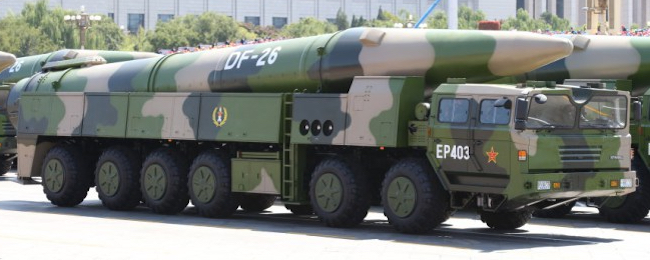
The DF-26 IRBM is “fielding” but the Pentagon report does not yet include it in the total missile count.
The road-mobile DF-26 will complement the existing force of DF-21 medium-range missiles, of which two versions are nuclear-capable, in China’s regional deterrence mission. And the DF-26 will probably replace the old liquid-fueled DF-4. The other old liquid-fueled missile, the DF-3A, now appears to have been retired.
The SSBN Force
The Pentagon report lists four Jin-class (Type-024) SSBNs as commissioned and “others under construction.” All Jin SSBNs are homeported at the Longpo Naval Base on Hainan Island. The report declares that “China’s JIN SSBNs, which are equipped to carry up to 12 CSS-N-14 (JL-2) SLBMs, are the country survivable sea-based nuclear deterrent.”
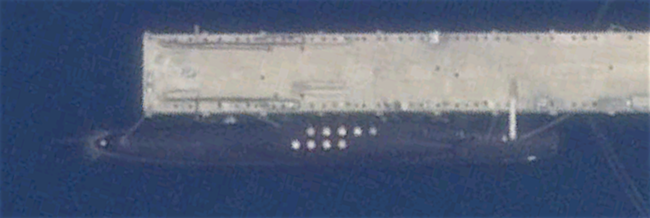
One of the four Jin-class SSBNs based at Longpo Naval Base on Hainan Island flashes nine of twelve SLBM tubes. Image: DigitalGlobe via GoogleEarth, April 17, 2016.
There are probably several caveats buried in that assessment. First, “survivable” requires that the SSBNs, once deployed at sea, can hide and avoid detection by US and allied anti-submarine warfare capabilities. Jin SSBNs apparently are rather noisy. Second, is the JL-2 operational on the SSBNs? Do they deploy with the missiles, train with them, and do they practice deterrent patrols and launch procedures?
The operational status is unclear from the report, which instead describes an effort to develop “more sophisticated C2 systems and processes” for “future SSBN deterrence patrols…” Rather, the Jin SSBNs appear to be a work in progress.
One indication the Jin-class might not constitute a “survivable” capability is that development of a replacement has already started. The future SSBN, which the Pentagon report says might begin construction in the early-2020s, reportedly will be equipped with a new SLBM known as JL-3. The new missile will probably have longer range than the current JL-2, which is insufficient to target the continental United Stated from Chinese waters.
Once China develops an operational aircraft carrier battle group, the report predicts, it would also be able to protect nuclear ballistic missile submarines stationed on Hainan Island. China has already built a carrier pier at the Yulin Naval Base on Hainan Island (see image below). Like so many other things, such a carrier battle group mission would depend on a number of things, not least how survivable it will be and how effective its anti-submarine capability will be.

The Liaoning docked at the carrier pier at Yulin Naval Base on Hainan Island. Image: DigitalGlobe via GoogleEarth, December 3, 2013.
Additional information:
- Pentagon Annual Report To Congress: Military and Security Developments Involving the People’s Republic of China 2017
- FAS Nuclear Notebook: Chinese Nuclear Forces 2016
- Status of World Nuclear Forces
This publication was made possible by a grant from the Carnegie Corporation of New York, the New Land Foundation, and the Ploughshares Fund. The statements made and views expressed are solely the responsibility of the author.
Latest Nuclear Weapon Declassifications
The fact that a particular nuclear weapon has (or does not have) a “dial-a-yield capability” enabling the selection of a desired explosive yield was declassified earlier this year, in a joint decision of the Department of Defense and the Department of Energy.
Last year, the Department of Energy also declassified the thickness of the “getter nickel plating” used in tritium production. (A “getter” here means the reactive material that sustains a vacuum by capturing gas atoms.)
These and several other recent DOE declassification decisions were recorded in memoranda that were released last week under the Freedom of Information Act. Copies are available, along with the records of prior DOE declassification actions, here.
Bethe, Oppenheimer and Teller: Their Accomplishments
In 1959, physicists Hans Bethe, J. Robert Oppenheimer and Edward Teller were candidates to receive the Enrico Fermi Award for contributions to the development of atomic energy.
In a newly discovered letter written in June 1959, Los Alamos physicist Norris Bradbury provided his evaluation of the achievements of each of the three eminent scientists. His letter was published last month for the first time, with an introduction by historian Roger Meade. See Bethe, Oppenheimer, Teller and the Fermi Award: Norris Bradbury Speaks, Los Alamos National Laboratory, April 28, 2017.
After assessing the accomplishments of the three of them at some length, Bradbury concluded that they were all deserving of the Fermi Award.
“I have no solution to this dilemma to propose other than the not entirely facetious suggestion that a joint award to all three individuals be made — with the additional proviso that it would be expected to make the same triply joint award for the two following years!”
As it turned out, Dr. Meade recalled in a footnote, Bethe received the award in 1961, Teller received it in 1962, and Oppenheimer in 1963.
B-52 Bomber No Longer Delivers Nuclear Gravity Bombs
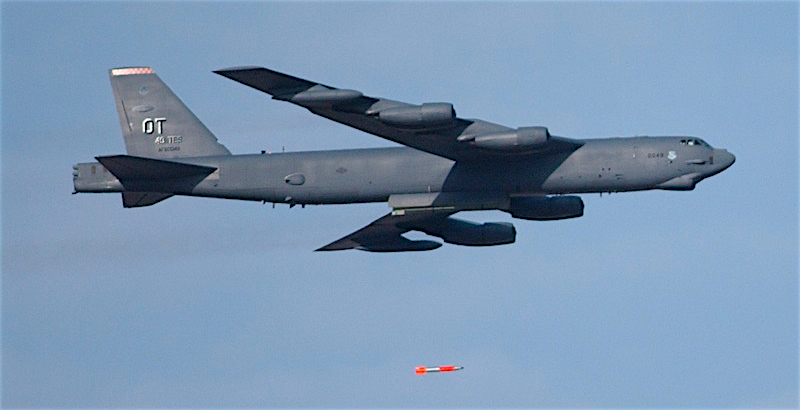
A B-52H bomber conducts a B61-7 nuclear gravity bomb drop test at the Tonopah Test Range in Nevada. Image: NNSA
By Hans M. Kristensen
The venerable B-52H Stratofortress long-range bomber is no longer listed by the National Nuclear Security Administration (NNSA) with a capability to deliver nuclear gravity bombs.
US Strategic Command (STRATCOM) apparently has not been assigning nuclear gravity bombs to B-52 bombers since at least 2010. Today, only the 20 B-2 stealth-bombers are tasked with strategic nuclear gravity bombs under the nuclear strike plans.
The reason for the change appears to be that the B-52 is no longer considered survivable enough to slip through modern air-defenses and drop nuclear gravity bombs on enemy territory.
The B-52s is still equipped to carry the nuclear-armed air-launched cruise missile (ALCM or AGM-86B), which can be launched from well outside the reach of air-defenses, and is scheduled to receive the new LRSO (Long Range Standoff Missile) by the late-2020s (even though that’s probably unnecessary).
Nuclear Tell Signs
The loss of the B-52 nuclear gravity bomb mission is visible in NNSA’s Budget Request for FY2018, which only lists the B-2 as carrier of the strategic nuclear gravity bombs. The Budget Request for FY2017, in contrast, also listed the B-52 as carrier of the B61-7 and B83-1 bombs (see below).
Update (thanks to hint from Dave): The loss of nuclear gravity bombs is also apparent from the latest update to the Department of Defense’s 2016 volume of Nuclear Matters Handbook. Whereas the 2015 version listed the B-52H with nuclear gravity bombs, chapter 3 of the 2016 version only listed ALCM (see comparison below).
The change is also apparent from photos that over the years were used by the Air Force to showcase the B-52’s firepower. One photo from between 1990 and 2007 shows a B-52 at Barksdale AFB in Louisiana with ALCM and ACM (Advanced Cruise Missile, or AGM-129A) cruise missiles, and B61 and B83 gravity bombs. A later photo from 2016, however, shows the significantly modified loadout of a B-52 at Minot AFB in North Dakota with ALCM cruise missiles but no nuclear gravity bombs. Instead, the bomber’s modernized loadout includes significant new conventional capabilities such as JDAM and SDB guided bombs, and the JASSM cruise missile (see below).
Gradual Nuclear Decline
The B-52 used to be equipped to carry a wide variety of nuclear weapons. Over the years many nuclear weapon have come and gone but the B-52 has endured. In the 1980s, for example, the B-52 was equipped for five different types of nuclear weapons: the 1.4-megaton B28 bomb, the 9-megaton B53 bomb, the 1.2-megaton B83 bomb, the B61 bomb, and the ALCM (see picture below).
When the Advanced Cruise Missile (ACM) entered service in 1990 it was also added to the B-52 nuclear portfolio. Despite the new ALCM and ACM standoff weapons (the ACM was retired in 2007, however, the B-52 continued to be assigned missions with nuclear gravity bombs. The 9-megaton B53 that was declared unsafe in 1991 was retained in the stockpile until 1997 for delivery by B-52s against super-hardened underground targets.
Instead of nuclear weapons, however, the overall trend is clear: the B-52 has been gradually shifting from nuclear to conventional missions. The most recent example is the conversion of some of the nuclear CSRLs (Common Strategic Rotary Launcher) to the Conventional Rotary Launcher (CRL) that can accommodate a wider host of advanced conventional weapons in the bomb bay, including the long-range JASSM-ER that is replacing the conventional ALCM (CALCM).
Given that the new LRSO will also be integrated on the B-2 and the new B-21 bombers, and the B-52 now has long-range conventional standoff JASSM-ER missiles, the B-52 could probably be phased out of the nuclear mission when the ALCM retires in the late-2020s.
The apparent removal of the B-52 from the nuclear gravity bomb mission is particularly important now because NNSA and the military are promising that once they get the new B61-12 guided nuclear bomb then the overall number of nuclear gravity bombs in the stockpile can be reduced by 50%. That promise was an important sales pitch in convincing the Obama administration that the B61-12 modernization was consistent with the goal of reducing the number of nuclear weapons. What the B61-12 lobbyists did not say was that most (if not all) of those 50% of the nuclear gravity bombs were already in excess of national security needs and could have been retired years ago.
Additional background information:
- FAS Nuclear Notebook: US nuclear forces, 2017 (note: publication was researched and produced before the Obama administration announced 500-warhead reduction of stockpile in early 2017. Our updated numbers are here).
- Increasing Nuclear Bomber Operations.
- LRSO: The Nuclear Cruise Missile Mission.
- Forget LRSO: JASSM Can Do The Job.
- W80-1 Warhead Selected For New Nuclear Cruise Missile.
- B-2 Stealth Bomber To Carry New Nuclear Cruise Missile.
This publication was made possible by a grant from the Carnegie Corporation of New York, the New Land Foundation, and the Ploughshares Fund. The statements made and views expressed are solely the responsibility of the author.
Garwin on Strategic Security Challenges to the US
There are at least four major “strategic security challenges” that could place the United States at risk within the next decade, physicist Richard L. Garwin told the National Academy of Sciences earlier this month.
“The greatest threat, based on expected value of damage, is cyberattack,” he said. Other challenges arise from the actions of North Korea and Iran, due to their pursuit or acquisition of nuclear weapons and/or missiles. The remaining threat is due to the potential instability associated with the existing U.S. nuclear weapon arsenal.
These four could be ordered, he said, by the relative difficulty of reducing the threat, from “easiest” to hardest: “the Iranian nuclear program; North Korea; the U.S. nuclear weapon capability and its evolution; and, finally, most importantly and probably most difficult of solution, the cyber threat to the United States.”
In his remarks, Garwin characterized each of the challenges and discussed possible steps that could be taken to mitigate the hazards involved. See Strategic Security Challenges for 2017 and Beyond, May 1, 2017.
Among many other things, Dr. Garwin is a former board member of the Federation of American Scientists. He was awarded the Presidential Medal of Freedom by President Obama last November. He was the subject of a biography published earlier this year called True Genius by Joel Shurkin. Many of his publications are archived on the FAS website.
Most of the threats identified by Garwin — other than the one posed by the U.S. nuclear weapon arsenal — were also discussed in the Worldwide Threat Assessment of the US Intelligence Community that was presented to the Senate Intelligence Committee on May 11.
Neither Garwin nor the US Intelligence Community considered the possibility that the US Government could ever be threatened from within. But that is what is now happening, former Director of National Intelligence James R. Clapper told CNN on May 14.
“I think […] our institutions are under assault internally,” Clapper said, referring to recent actions by President Trump, including the abrupt termination of FBI director James Comey. “The founding fathers, in their genius, created a system of three co-equal branches of government and a built-in system of checks and balances,” he said. “I feel as though that is under assault and is eroding.”
Life-of-the-Ship Reactors and Accelerated Testing of Naval Propulsion Fuels and Reactors
This special report is a result of the FAS U.S.-French Naval Nuclear Task Force and is focused on the life-of-the-ship reactors and role of accelerated testing on naval propulsion fuels and reactors. The report is written by Dr. George Moore.
https://issuu.com/fascientists/docs/life-of-the-ship-reactors-and-accel
New START 2017: Russia Decreasing, US Increasing Deployed Warheads
By Hans M. Kristensen
The latest set of New START aggregate data released by the US State Department shows that Russia is decreasing its number of deployed strategic warheads while the United States is increasing the number of warheads it deploys on its strategic forces.
The Russian reduction, which was counted as of March 1, 2017, is a welcoming development following its near-continuous increase of deployed strategic warheads compared with 2013. Bus as I previously concluded, the increase was a fluctuation caused by introduction of new launchers, particularly the Borei-class SSBN.
The US increase, similarly, does not represent a buildup – a mischaracterization used by some to describe the earlier Russian increase – but a fluctuation caused by the force loading on the Ohio-class SSBNs.
Strategic Warheads
The data shows that Russia as of March 1, 2017 deployed 1,765 strategic warheads, down by 31 warheads compared with October 2016. That means Russia is counted as deploying 228 strategic warheads more than when New START went into force in February 2011. It will have to offload an additional 215 warheads before February 2018 to meet the treaty limit. That will not be a problem.
The number of Russian warheads counted by the New START treaty is only a small portion of its total inventory of warheads. We estimate that Russia has a military stockpile of 4,300 warheads with more retired warheads in reserve for a total inventory of 7,000 warheads.
The United States was counted as deploying 1,411 strategic warheads as of March 1, 2017, an increase of 44 warheads compared with the 1,367 strategic deployed warheads counted in October 2016. The United States is currently below the treaty limit and can add another 139 warheads before the treaty enters into effect in February 2018.
The number of US warheads counted by the New START treaty is only a small portion of its total inventory of warheads. We estimate that the United States has a military stockpile of 4,000 warheads with more retired warheads in reserve for a total inventory of 6,800 warheads.
Strategic Launchers
The New START data shows that Russia as of March 1, 2017 deployed 523 strategic launchers, an increase of 15 launchers compared with October 2016. That means Russia has two (2) more launched deployed today than when New START entered into force in February 2011.
Russia could hypothetically increase its force structure by another 177 launchers over the next ten months and still be in compliance with New START. But its current nuclear modernization program is not capable of doing so.
Under the treaty, Russia is allowed to have a total of 800 deployed and non-deployed strategic launchers. The data shows that it currently has 816, only 16 above the treaty limit. That means Russia overall has scrapped 49 total launchers (deployed and non-deployed) since New START was signed in February 2011.
The United States is counted as deploying 673 strategic launchers as of March 1, 2017, a decrease of eight (8) launchers compared with October 2016. That means the United States has reduced its force structure by 209 deployed strategic launchers since February 2011.
The US reduction has been achieved by stripping essentially all excess bombers of nuclear equipment, reducing the ICBM force to roughly 400, and making significant progress on reducing the number of launch tubes on each SSBN from 24 to 20.
The United States is below the limit for strategic launchers and could hypothetically add another 27 launchers, a capability it currently has. Overall, the United States has scrapped 304 total launchers (deployed and non-deployed) since the treaty entered into force in February 2011, most of which were so-called phantom launchers that were retired but still contained equipment that made them accountable under the treaty.
The United States currently is counted as having 820 deployed and non-deployed strategic launchers. It will need to destroy another 20 to be in compliance with New START by February 2018.
Conclusions and Outlook
Both Russia and the United States are on track to meet the limits of the New START treaty by February 2018. The latest aggregate data shows that Russia is again reducing its deployed strategic warheads and both countries are already below the treaty’s limit for deployed strategic launchers.
In a notorious phone call between Russian President Vladimir Putin and US President Donald Trump, the Russian president reportedly raised the possibility of extending the New START treaty by another five years beyond 2021. But Trump apparently brushed aside the offer saying New START was a bad deal. After the call, Trump said the United States had “fallen behind on nuclear weapons capacity.”
In reality, the United States has not fallen behind but has 150 strategic launchers more than Russia. The New START treaty is not a “bad deal” but an essential tool to provide transparency of strategic nuclear forces and keeping a lid on the size of the arsenals. Russia and the United States should move forward without hesitation to extend the treaty by another five years.
Additional resources:
- New START Aggregate Data (as of March 1, 2017)
- Status of World Nuclear Forces
This publication was made possible by a grant from the New Land Foundation and Ploughshares Fund. The statements made and views expressed are solely the responsibility of the author.
JASON on Subcritical Nuclear Tests
Subcritical nuclear tests remain useful for maintaining the U.S. nuclear weapons stockpile in the absence of nuclear explosive testing, the JASON defense advisory panel affirmed in a letter report last year. But “a gap exists in the current US capability to carry out and diagnose such experiments,” the panel said.
Subcritical experiments simulate aspects of nuclear explosions using chemical explosives. But since a subcritical mass of plutonium (or a surrogate material) is used, no actual nuclear explosion occurs.
The main purpose of subcritical experiments is to identify and decrease uncertainties in weapon performance. “For all weapons in the current stockpile, at the present time margins are adequate and uncertainties are within margins, both for normal operation and for nuclear safety should accidents occur,” the JASON panel said. “However, future aging of these weapons and their remanufacture may increase uncertainties, and JASON finds that scaled [subcritical] experiments in Pu [plutonium] may significantly reduce uncertainties that may arise in the future.”
But “JASON finds that x-ray radiography is needed to diagnose subcritical experiments in Pu… and that the US currently lacks adequate radiography at U1a [the nuclear complex in Nevada] for this purpose.”
The JASON letter report was prepared for the National Nuclear Safety Administration at the direction of Congress. A copy was released by NNSA last week under the Freedom of Information Act.
See Enhanced Capabilities for Subcritical Experiments, JSR-16-Task-011, October 7, 2016.
Warhead “Super-Fuze” Increases Targeting Capability Of US SSBN Force
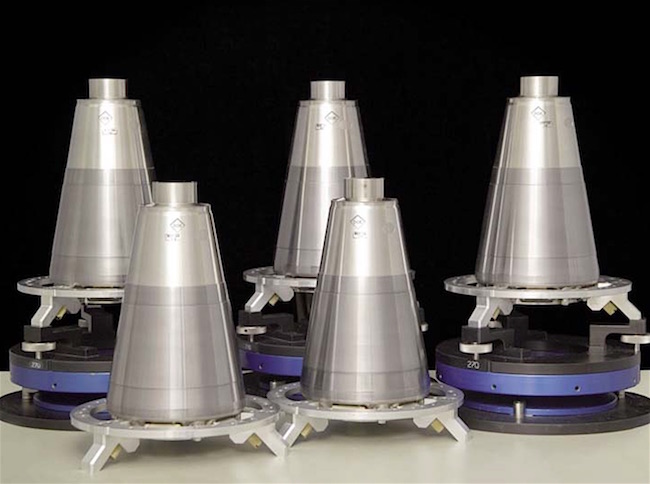
The MC7400 AF&F unit on the new W76-1/Mk4A warhead contains a super-fuze that dramatically increases its hard target kill capability. Image: Sandia National Laboratories
By Hans M. Kristensen
Under the cover of an otherwise legitimate life-extension of the W76 warhead, the Navy has quietly added a new super-fuze to the warhead that dramatically increases the ability of the Navy to destroy hard targets in Russia and other adversaries.
In a new article in the Bulletin of the Atomic Scientists Matthew McKinzie from NRDC, Theodore A. Postol from MIT, and I describe the impact of the super-fuze on the targeting capability of the US SSBN force and how it might effect strategic stability.
The new super-fuze dramatically increases the capability of the W76 warhead to destroy hard targets, such as Russian ICBM silos.
We estimate that the super-fuze capability is now operational on all nuclear warheads deployed on the Navy’s Ohio-class ballistic missile submarines. The new fuze has also been installed on warheads on British SSBN.
“As a consequence, the US submarine force today is much more capable than it was previously against hardened targets such as Russian ICBM silos. A decade ago, only about 20 percent of US submarine warheads had hard-target kill capability; today they all do.”
The new article builds on previous work by Ted Postol and myself but with new analysis explaining how the super-fuze works.
In the article we conclude that the SSBN force, rather than simply being a stable retaliatory capability, with the new super-fuze increasingly will be seen as a front-line, first-strike weapon that is likely to further fuel trigger-happy, worst-case planning in other nuclear-armed states.
Read full article here: Hans M. Kristensen, Matthew McKinzie, Theodore A. Postol, “How US nuclear force modernization is undermining strategic stability: The burst-height compensating super-fuze,” Bulletin of the Atomic Scientists, March 1, 2017.
Previous writings about the super-fuze:
- Theodore A. Postol, “How the Obama Administration Learned to Stop Worrying and Love the Bomb,” The Nation, December 10, 2014.
- Hans M. Kristensen, “British Submarines to Receive Upgraded US Nuclear Warhead,” FAS Strategic Security Blog, April 1, 2011.
- Hans M. Kristensen, “Administration Increases Submarine Nuclear Warhead Production Plan,” FAS Strategic Security Blog, August 30, 2007.
- Hans M. Kristensen, “Small Fuze – Big Effect,” FAS Strategic Security Blog, March 14, 2017.
This publication was made possible by a grant from Carnegie Corporation of New York and Ploughshares Fund. The statements made and views expressed are solely the responsibility of the author.
Talk At The Nuclear Deterrence Summit
Today I spoke at the Nuclear Deterrence Summit about the role and challenges of US-Russian nuclear arms control efforts. My panel partner was Mark Schneider from NIPP and we were under the competent chairmanship of Vice Admiral Van Mauney (US Navu, Ret.), the former deputy commander of US Strategic Command.
My prepared remarks are here: Beyond US-Russian Arms Control
This publication was made possible by a grant from Carnegie Corporation of New York and Ploughshares Fund. The statements made and views expressed are solely the responsibility of the author.
